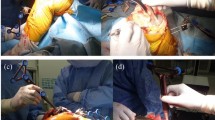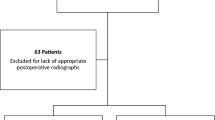Abstract
Purpose
It remains to be established whether optical computed tomography (CT)-free and acceleration-based navigation systems differ in terms of implantation accuracy and clinical outcomes for total knee arthroplasty. This randomised prospective study compared the implantation accuracy of these two navigation systems in total knee arthroplasty.
Methods
Optical CT-free navigation (ExactechGPS) or acceleration-based navigation (KneeAlign2) was randomly assigned to the left or right knee of 45 patients who underwent a single-stage bilateral total knee arthroplasty: the ExactechGPS (n = 45) and KneeAlign2 groups (n = 45) were compared. Component alignments were evaluated using three-dimensional computed tomography and radiography at pre- and post-surgery. Implantation accuracy of the component alignment, proportion of outliers, postoperative range of motion, and Japanese Orthopaedic Association (JOA) score were compared between the systems.
Results
The implantation accuracies of the lower-extremity mechanical alignment, coronal femoral component angle, coronal tibial component angle, sagittal femoral component, axial femoral angle, and axial tibial angle had no significant difference between the groups. The implantation accuracy of the sagittal tibial component angle was superior in the ExactechGPS than the KneeAlign2 group (1.3° vs. 1.8°, P = 0.034). The proportions of outliers, range of motion, and JOA score had no significant difference between the groups.
Conclusion
In the tibial sagittal plane, there was a significant difference in the implantation accuracy, but its difference did not affect the clinical outcomes. Both navigation systems have clinically acceptable implantation accuracy.



Similar content being viewed by others
Availability of data and material
Not applicable.
Code availability
Not applicable.
References
Ritter MA, Davis KE, Meding JB, Pierson JL, Berend ME, Malinzak RA (2011) The effect of alignment and BMI on failure of total knee replacement. J Bone Jt Surg Am 93:1588–1596. https://doi.org/10.2106/jbjs.j.00772
Jorgensen NB, McAuliffe M, Orschulok T, Lorimer MF, de Steiger R (2019) Major aseptic revision following total knee replacement: a study of 478,081 total knee replacements from the Australian Orthopaedic Association National Joint Replacement Registry. J Bone Jt Surg Am 101:302–310. https://doi.org/10.2106/jbjs.17.01528
Lee BS, Cho HI, Bin SI, Kim JM, Jo BK (2018) Femoral component varus malposition is associated with tibial aseptic loosening after TKA. Clin Orthop Relat Res 476:400–407. https://doi.org/10.1007/s11999.0000000000000012
Liu HX, Shang P, Ying XZ, Zhang Y (2016) Shorter survival rate in varus-aligned knees after total knee arthroplasty. Knee Surg Sports Traumatol Arthrosc 24:2663–2671. https://doi.org/10.1007/s00167-015-3781-7
Mason JB, Fehring TK, Estok R, Banel D, Fahrbach K (2007) Meta-analysis of alignment outcomes in computer-assisted total knee arthroplasty surgery. J Arthroplasty 22:1097–1106. https://doi.org/10.1016/j.arth.2007.08.001
Brin YS, Nikolaou VS, Joseph L, Zukor DJ, Antoniou J (2011) Imageless computer assisted versus conventional total knee replacement. A Bayesian meta-analysis of 23 comparative studies. Int Orthop 35:331–339. https://doi.org/10.1007/s00264-010-1008-6
Liow MH, Goh GS, Pang HN, Tay DK, Lo NN, Yeo SJ (2016) Computer-assisted stereotaxic navigation improves the accuracy of mechanical alignment and component positioning in total knee arthroplasty. Arch Orthop Trauma Surg 136:1173–1180. https://doi.org/10.1007/s00402-016-2483-z
Anderson KC, Buehler KC, Markel DC (2005) Computer assisted navigation in total knee arthroplasty: comparison with conventional methods. J Arthroplasty 20:132–138. https://doi.org/10.1016/j.arth.2005.05.009
Mizuuchi H, Matsuda S, Miura H, Okazaki K, Akasaki Y, Iwamoto Y (2008) The evaluation of post-operative alignment in total knee replacement using a CT-based navigation system. J Bone Jt Surg Br 90:1025–1031. https://doi.org/10.1302/0301-620x.90b8.20265
Loh B, Chen JY, Yew AKS, Pang HN, Tay DKJ, Chia SL, Lo NN, Yeo SJ (2017) The accuracy of a hand-held navigation system in total knee arthroplasty. Arch Orthop Trauma Surg 137:381–386. https://doi.org/10.1007/s00402-016-2612-8
Hetaimish BM, Khan MM, Simunovic N, Al-Harbi HH, Bhandari M, Zalzal PK (2012) Meta-analysis of navigation vs conventional total knee arthroplasty. J Arthroplasty 27:1177–1182. https://doi.org/10.1016/j.arth.2011.12.028
Zahn RK, Graef F, Conrad JL, Renner L, Perka C, Hommel H (2020) Accuracy of tibial positioning in the frontal plane: a prospective study comparing conventional and innovative techniques in total knee arthroplasty. Arch Orthop Trauma Surg 140:793–800. https://doi.org/10.1007/s00402-020-03389-4
Nam D, Weeks KD, Reinhardt KR, Nawabi DH, Cross MB, Mayman DJ (2013) Accelerometer-based, portable navigation vs imageless, large-console computer-assisted navigation in total knee arthroplasty: a comparison of radiographic results. J Arthroplasty 28:255–261. https://doi.org/10.1016/j.arth.2012.04.023
Matsumoto T, Kubo S, Muratsu H, Tsumura N, Ishida K, Matsushita T, Takayama K, Sasaki H, Oka S, Kurosaka M, Kuroda R (2011) Differing prosthetic alignment and femoral component sizing between 2 computer-assisted CT-free navigation systems in TKA. Orthopedics 34:e860–e865. https://doi.org/10.3928/01477447-20111021-35
Sasaki H, Ishida K, Shibanuma N, Takayama K, Hayashi S, Hashimoto S, Niikura T, Kurosaka M, Kuroda R, Matsumoto T (2018) Comparison of coronal prosthetic alignment after total knee arthroplasty using 3 computer-assisted navigation systems. Orthopedics 41:e621–e628. https://doi.org/10.3928/01477447-20180711-02
Goh GSH, Liow MHL, Tay DKJ, Lo NN, Yeo SJ, Tan MH (2018) Accelerometer-based and computer-assisted navigation in total knee arthroplasty: a reduction in mechanical axis outliers does not lead to improvement in functional outcomes or quality of life when compared to conventional total knee arthroplasty. J Arthroplasty 33:379–385. https://doi.org/10.1016/j.arth.2017.09.005
Moher D, Schulz KF, Altman D, CONSORT Group (Consolidated Standards of Reporting Trials) (2001) The CONSORT statement: revised recommendations for improving the quality of reports of parallel-group randomized trials. JAMA 285:1987–1991. https://doi.org/10.1001/jama.285.15.1987
Akagi M, Mori S, Nishimura S, Nishimura A, Asano T, Hamanishi C (2005) Variability of extraarticular tibial rotation references for total knee arthroplasty. Clin Orthop Relat Res 436:172–176. https://doi.org/10.1097/01.blo.0000160027.52481.32
Yoshino K, Hagiwara S, Nakamura J, Tsukeoka T, Tsuneizumi Y, Ohtori S (2019) Intra- and interobserver reliability and agreement in three-dimensional computed tomography measurements of component positions after total knee arthroplasty. Knee 26:1102–1110. https://doi.org/10.1016/j.knee.2019.07.001
Zhu M, Lindsay E, Keenan A, Monk P, Munro J (2020) The use of accelerometer-based navigation for coronal TKA alignment: a prospective, single surgeon comparative study. Arch Orthop Trauma Surg 140:1169–1174. https://doi.org/10.1007/s00402-019-03295-4
Kim YH, Kim JS, Yoon SH (2007) Alignment and orientation of the components in total knee replacement with and without navigation support: a prospective, randomised study. J Bone Jt Surg Br 89:471–476. https://doi.org/10.1302/0301-620x.89b4.18878
Okuda M, Omokawa S, Tanaka Y, Okahashi K, Akahane M (2012) Validity and reliability of the Japanese Orthopaedic Association score for osteoarthritic knees. J Orthop Sci 17:750–756. https://doi.org/10.1007/s00776-012-0274-0
R Core Team (2018) R: a language and environment for statistical computing. R Foundation for Statistical Computing, Vienna, Austria. https://www.r-project.org/ Cited 15 Oct 2019
Schmitt J, Hauk C, Kienapfel H, Pfeiffer M, Efe T, Fuchs-Winkelmann S, Heyse TJ (2011) Navigation of total knee arthroplasty: rotation of components and clinical results in a prospectively randomized study. BMC Musculoskelet Disord 12:16. https://doi.org/10.1186/1471-2474-12-16
Pang CH, Chan WL, Yen CH, Cheng SC, Woo SB, Choi ST, Hui WK, Mak KH (2009) Comparison of total knee arthroplasty using computer-assisted navigation versus conventional guiding systems: a prospective study. J Orthop Surg (Hong Kong) 17:170–173. https://doi.org/10.1177/230949900901700209
Zhang G, Chen J, Chai W, Liu M, Wang Y (2011) Comparison between computer-assisted-navigation and conventional total knee arthroplasties in patients undergoing simultaneous bilateral procedures: a randomized clinical trial. J Bone Jt Surg Am 93:1190–1196. https://doi.org/10.2106/jbjs.i.01778
Nam D, Cody EA, Nguyen JT, Figgie MP, Mayman DJ (2014) Extramedullary guides versus portable, accelerometer-based navigation for tibial alignment in total knee arthroplasty: a randomized, controlled trial: winner of the 2013 HAP PAUL award. J Arthroplasty 29:288–294. https://doi.org/10.1016/j.arth.2013.06.006
Shoji H, Teramoto A, Suzuki T, Okada Y, Watanabe K, Yamashita T (2018) Radiographic assessment and clinical outcomes after total knee arthroplasty using an accelerometer-based portable navigation device. Arthroplast Today 4:319–322. https://doi.org/10.1016/j.artd.2017.11.012
Ueyama H, Matsui Y, Minoda Y, Matsuura M, Nakamura H (2017) Using accelerometer-based portable navigation to perform accurate total knee arthroplasty bone resection in Asian patients. Orthopedics 40:e465–e472. https://doi.org/10.3928/01477447-20170223-01
Delp SL, Stulberg SD, Davies B, Picard F, Leitner F (1998) Computer assisted knee replacement. Clin Orthop Relat Res 354:49–56. https://doi.org/10.1097/00003086-199809000-00007
Krackow KA, Bayers-Thering M, Phillips MJ, Bayers-Thering M, Mihalko WM (1999) A new technique for determining proper mechanical axis alignment during total knee arthroplasty: progress toward computer-assisted TKA. Orthopedics 22:698–702
Yoshioka Y, Siu DW, Scudamore RA, Cooke TD (1989) Tibial anatomy and functional axes. J Orthop Res 7:132–137. https://doi.org/10.1002/jor.1100070118
Schmitt J, Hauk C, Kienapfel H, Pfeiffer M, Efe T, Fuchs-Winkelmann S, Heyse TJ (2011) Navigation of total knee arthroplasty: rotation of components and clinical results in a prospectively randomized study. BMC Musculoskelet Disord 12:1–8. https://doi.org/10.1186/1471-2474-12-16
Lützner J, Krummenauer F, Wolf C, Günther KP, Kirschner S (2008) Computer-assisted and conventional total knee replacement: a comparative, prospective, randomised study with radiological and CT evaluation. J Bone Jt Surg Br 90:1039–1044. https://doi.org/10.1302/0301-620x.90b8.20553
Kuriyama S, Hyakuna K, Inoue S, Tamaki Y, Ito H, Matsuda S (2014) Tibial rotational alignment was significantly improved by use of a CT-navigated control device in total knee arthroplasty. J Arthroplasty 29:2352–2356. https://doi.org/10.1016/j.arth.2014.06.016
Mizu-Uchi H, Matsuda S, Miura H, Okazaki K, Akasaki Y, Iwamoto Y (2008) The evaluation of post-operative alignment in total knee replacement using a CT-based navigation system. J Bone Jt Surg Br 90:1025–1031. https://doi.org/10.1302/0301-620x.90b8.20265
Ohmori T, Kabata T, Kajino Y, Inoue D, Taga T, Yamamoto T, Takagi T, Yoshitani J, Ueno T, Ueoka K, Tsuchiya H (2018) A proposed new rotating reference axis for the tibial component after proximal tibial resection in total knee arthroplasty. PLoS ONE 13:e0209317. https://doi.org/10.1371/journal.pone.0209317
Corona K, Cerciello S, Vasso M, Toro G, Braile A, Arnold MP, Panni AS (2020) Femoral component malrotation is not correlated with poor clinical outcomes after total knee arthroplasty. Knee Surg Sports Traumatol Arthrosc 28:3879–3887. https://doi.org/10.1007/s00167-020-05880-2
Panni AS, Ascione F, Rossini M, Braile A, Corona K, Vasso M, Hirschmann MT (2018) Tibial internal rotation negatively affects clinical outcomes in total knee arthroplasty: a systematic review. Knee Surg Sports Traumatol Arthrosc 26:1636–1644. https://doi.org/10.1007/s00167-017-4823-0
Funding
No external funding was received in support of this study.
Author information
Authors and Affiliations
Contributions
The following are the four criteria for authorship. Substantial contributions to the conception or design, acquisition, analysis, or interpretation of data for the work. Drafting the work or revising it critically for important content. Final approval of the version to be published. Agreement to be accountable for all aspects of the work in ensuring that questions related to the accuracy or integrity of any part of the work are appropriately investigated and resolved.
Corresponding author
Ethics declarations
Conflict of interest
The authors declare that they have no conflict of interest.
Ethics approval
This study was approved by our institutional ethics committee and the UMIN clinical trial registry (Trial Registration No. UMIN000032420).
Consent to participate
We provided written informed consent for participation to all patients.
Consent for publication
We provided written informed consent for publication to all patients.
Additional information
Publisher's Note
Springer Nature remains neutral with regard to jurisdictional claims in published maps and institutional affiliations.
Rights and permissions
About this article
Cite this article
Saiki, Y., Ojima, T., Kabata, T. et al. Accuracy of different navigation systems for femoral and tibial implantation in total knee arthroplasty: a randomised comparative study. Arch Orthop Trauma Surg 141, 2267–2276 (2021). https://doi.org/10.1007/s00402-021-04205-3
Received:
Accepted:
Published:
Issue Date:
DOI: https://doi.org/10.1007/s00402-021-04205-3




